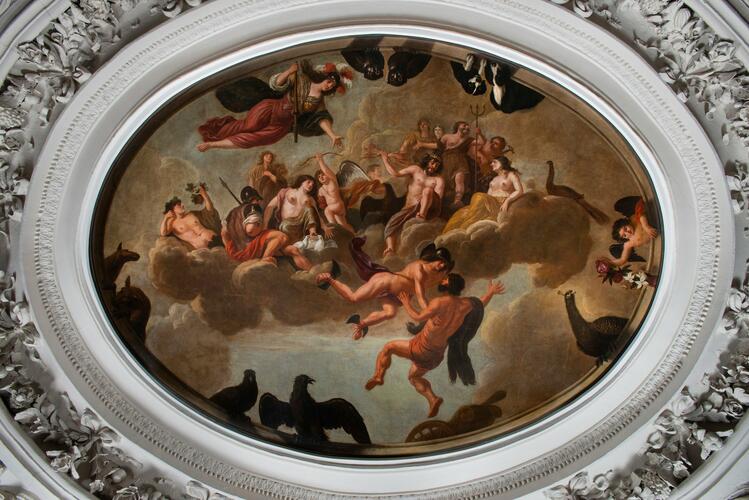The Apotheosis of Hercules Signed and dated 1675
Oil on canvas | 219.0 x 297.0 cm (support, canvas/panel/stretcher external) | RCIN 401239
-
The Dutch artist Jacob de Wet II was brought from Amsterdam to Edinburgh in 1673 by Sir William Bruce, King’s Surveyor and Master of Works in Scotland. As part of a team of skilled British and foreign craftsmen furnishing the newly rebuilt Palace of Holyroodhouse, de Wet produced a series of decorative history paintings for the state apartments. Still in situ, these include Bathing Scene by a River (RCIN 401237), Galatea and Polyphemus (RCIN 401238), The Apotheosis of Hercules (RCIN 401239) The Infant Hercules strangling Serpents (RCIN 401240) and The Finding of Moses (RCIN 401241). This illusionistic ceiling painting (painted di sotto in sù or ‘seen from below’) shows the ascension of Hercules to Mount Olympus, the seat of the gods in Greek mythology. While twelve is Olympus’ traditional number of gods, de Wet’s celestial kingdom includes as many as fifteen. Hercules, his arms and legs flailing, is pulled towards Olympus by Hermes (Mercury), identified by his winged sandals and helmet. Seated above to their right is Zeus (Jupiter). His crown makes clear his supreme power as king of the gods and his fistful of thunderbolts that he is lord of the sky and controlled the weather. Another attribute of Zeus, the eagle, is perched to the left. To the right is his wife Hera (Juno) whose peacock can be seen on a cloud next to her. Holding a trident between Zeus and Hera is Poseidon (Neptune), and next to him – hammer in hand – is Hephaestus (Vulcan), the gods’ master blacksmith. On the other side of Zeus stands Eros (Cupid), immediately recognizable by his wings and bow. Eros faces his mother Aphrodite (Venus) who has doves at her feet, a common attribute of the goddess of love. Beside her clad in armour is Ares (Mars), the god of war, whose back is turned away from the viewer towards Aphrodite, his lover. Behind this couple, crowned with corn and carrying a cornucopia, is Demeter (Ceres) goddess of harvest, and to the left Dionysus (Bacchus) the god of wine, recognisable by the vines in his hair and the grapes he is carrying. Floating above with a helmet and spear is Athena (Minerva), who was his principal protector. Behind Neptune are two gods male and female, one of whom is likely to be Apollo. The other is probably Artemis (Diana): as goddess of the hunt dogs were a common symbol of hers, and indeed two dogs are situated nearby at the edge of the painting. The final head in the distance could be any of the minor gods not usually associated with Olympus. The greatest of Greek heroes, Hercules was the ultimate symbol of courage, strength and masculine virtue. The illegitimate offspring of Zeus and Alcmena, a mortal, Hercules was famous above all for his superhuman strength, performing his Twelve Labours as an act of penance for killing his wife and children in a fit of madness. Their completion brought him a hard-won immortality: suffering a gruesome death through the centaur Nessus’ trickery, the hero is finally admitted to Olympus by his father Zeus. In the Renaissance Hercules was widely seen as the classical equivalent of Christ: half-man, half-god, his trials and tribulations administered by the jealous Hera were directly compared with Christ’s Passion. Apotheoses themselves were also Christianized in art: in the Church of Sant’Ignazio, Rome is the famous ceiling painting by Andrea Pozzo also in di sotto in sù perspective showing Saint Ignatius being borne up to Heaven by angels (after 1685). The apotheosis of Hercules was a very popular subject in late Baroque art and was often used to promote royal absolutism, most famously by François le Moyne’s work for Louis XV in the Palace of Versailles (c.1733-6). The Apotheosis of Hercules is situated in the King’s Bedchamber. The most important room in the Palace of Holyroodhouse, this richly decorated interior is the climax of the procession through the state apartments. Installed with its iconographic counterpart The Infant Hercules Strangling Serpents (RCIN 401240), these were two of de Wet’s most accomplished paintings at Holyrood and were intended to impress a socially very exclusive audience. The comparison it invites between Hercules and Charles II is extremely flattering and certainly intentional: ruling Scotland by ‘divine right’, the valiant deeds of this Christ-like king have already earned him his place in Heaven. The trompe l’oeil around the oval edge of the painting, where animal paws and heads seem to peer over and out of the work, gives the impression that the viewer is looking through the ceiling into the heavens above. Although somewhat unspectacular to modern eyes, de Wet’s di sotto in sù was meant to remind viewers of other works they may have seen on the continent, including Mantegna’s famous trompe l’oeil oculus in the Camera degli Sposi in the Ducal Palace of Mantua, which de Wet could have known through prints.
Provenance
Commissioned by Sir William Bruce on behalf of Charles II.
-
Medium and techniques
Oil on canvas
Measurements
219.0 x 297.0 cm (support, canvas/panel/stretcher external)
Category
Object type(s)
Other number(s)
OM add-de WetAlternative title(s)
Hercules Admitted to Olympus
Orion cast out of Heaven, previously identified as
Mount Olympus









